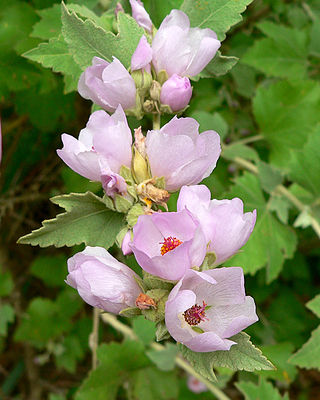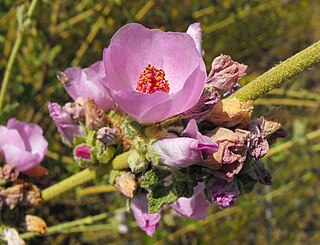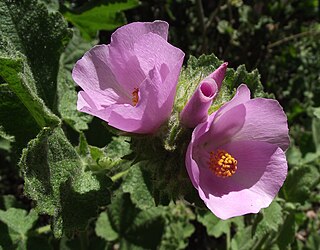
Malacothamnus (bushmallow) is a genus of shrubs found throughout much of mainland California and on three of the Channel Islands. Outside of California, Malacothamnus is known from the northern half of Baja California and from a few disjunct locations in Arizona. Plants of this genus are most commonly found in early-successional, post-burn plant communities. Malacothamnus are currently thought to be most closely related to the Iliamnas of the US interior and the Phymosias of Mexico, Central America, and the Caribbean.
Malacothamnus abbottii is a rare species of flowering plant in the mallow family known by the common name Abbott's bushmallow. It is endemic to Monterey County, California, where it has recently been observed at only a few locations. It was historically known from a single specimen collection and the plant was presumed extinct until it was rediscovered in 1990 near San Ardo in the Salinas River drainage. It is now known from eleven occurrences, many of which are actually part of a single population, growing in vulnerable riverbeds near oil fields. Its habitat is periodically flooding riparian scrub among sandbar willows. This is a shrub with a slender, branching stem growing erect to a maximum height over one meter. It is coated in thin white hairs and bears toothed oval leaves a few centimeters long, sometimes divided into lobes. The inflorescence is a cluster of a few pale pink flowers with pointed oval petals 6 or 7 millimeters long.
Malacothamnus aboriginum is a species of flowering plant in the mallow family known by the common name Indian Valley bushmallow. It is endemic to the southern Coastal Ranges of California, primarily in the southern half of the Diablo Range and the Gabilan Range. Plants from San Diego County called Malacothamnus aboriginum in the past were described as the new species Malacothamnus enigmaticus in 2019.

Malacothamnus clementinus is a rare species of flowering plant in the mallow family known by the common name San Clemente Island bushmallow. It is endemic to San Clemente Island, one of the Channel Islands of California, where it is known from fewer than ten occurrences in the steep, rocky seaside canyons.

Malacothamnus davidsonii is a species of flowering plant in the mallow family known by the common names Tujunga bushmallow and Davidson's bushmallow. It is endemic to Los Angeles County, California, where it primary occurs in and near Big Tujunga Canyon, Little Tujunga Canyon, and Tujunga Wash. The common name Tujunga bushmallow alludes to its geographic distribution. Plants of what has historically been considered Malacothamnus davidsonii from Monterey and San Luis Obispo counties in California were described as the new species Malacothamnus discombobulatus in 2023 based on phylogenetic, morphological, and geographic evidence.
Malacothamnus densiflorus is a species of flowering plant in the mallow family, which has two varieties. It is endemic to the Peninsular Ranges of southwestern California and northwestern Baja California.

Malacothamnus fasciculatus is a species of flowering plant in the mallow family, which has four varieties. It is endemic to southwestern California and northwestern Baja California.
Malacothamnus fremontii is a species of flowering plant in the mallow family, which has two varieties, one of which is sometimes recognized as the species Malacothamnus helleri. Malacothamnus fremontii is known by the common names unfurled bushmallow and Frémont's bushmallow. Unfurled bushmallow is the suggested common name for people who do not wish to honor Fremont, who led multiple massacres against Indigenous peoples. Malacothamnus fremontii is endemic to northern California in and west of the Sierra Nevada.
Malacothamnus jonesii is a species of flowering plant in the mallow family which has three varieties, two of which are sometimes recognized at the species rank as Malacothamnus gracilis and Malacothamnus niveus. Malacothamnus jonesii is endemic to San Luis Obispo County, California and just over its northern and southern borders in Monterey and Santa Barbara counties.
Malacothamnus palmeri is a species of flowering plant in the mallow family known by the common names Cambria bushmallow and Palmer's bushmallow. It is endemic to San Luis Obispo County, California, where it is known from the Santa Lucia Mountains.
Malacothamnus enigmaticus is a species of flowering plant in the mallow family known by the common name enigmatic bush-mallow. It is endemic to the Peninsular Ranges of California and Baja California, Mexico extending from the San Ysidro Mountains in the north to the Sierra de San Pedro Mártir in the south. It was first collected in 1938 and described as a new species to science in 2019. Prior to 2019, it had been mistakenly assigned to Malacothamnus aboriginum and Malacothamnus densiflorus.

Malacothamnus lucianus is a species of flowering plant in the mallow family known by the common names Santa Lucia bushmallow and Arroyo Seco bushmallow and by the cultivar name Hanging Valley bushmallow. It is endemic to Monterey County, California, United States, where it is known from the Santa Lucia Mountains.
Malacothamnus involucratus is a species of flowering plant in the mallow family known by the common name Carmel Valley bushmallow. It is likely endemic to Monterey County, California, where it is known from Carmel Valley and the Jolon region. A single specimen is attributed to San Luis Obispo County, California but the origin of this specimen is questionable.
Malacothamnus mendocinensis is a species of flowering plant in the mallow family known by the common name Mendocino bushmallow. It is endemic to Mendocino County, California, where it is known from only two populations. It was presumed extinct until rediscovered in 2016 and now has a California Rare Plant Rank of 1B.1. In some treatments, Malacothamnus mendocinensis has been included within Malacothamnus fasciculatus or Malacothamnus hallii. Phylogenetic and morphological evidence, however, indicate that it is not closely related to these species and should be recognized as a separate species.
Malacothamnus arcuatus is a species of flowering plant in the mallow family, which has two varieties, one of which is sometimes recognized as the species Malacothamnus hallii.
Malacothamnus parishii is a species of flowering plant in the mallow family known by the common name Parish's bushmallow. It is endemic to San Bernardino County, California, where it is confirmed from only a single collection from 1895. It has a California Rare Plant Rank of 1A. Malacothamnus parishii is currently treated as an extreme form of Malacothamnus fasciculatus var. laxiflorus. Phylogenetic analyses are needed to confirm whether it should be treated as a separate species or not.
Malacothamnus orbiculatus is a species of flowering plant in the mallow family known by the common names Tehachapi bushmallow and round-leaved bushmallow. It occurs in California, where it is common after burns on the desert-facing slopes of mountains, and Arizona, where it is currently only known from a few locations. Malacothamnus orbiculatus is occasionally treated within Malacothamnus fremontii but morphological, phylogenetic, and geographic evidence shows them to be distinct species, though there is a small zone of intergradation where their geographic ranges meet.
Malacothamnus eastwoodiae is a species of flowering plant in the mallow family known by the common name Alice's lovely bushmallow. It is named after the botanist Alice Eastwood. It is endemic to Santa Barbara County, California and currently only known from Vandenberg Space Force Base.
Malacothamnus discombobulatus is a species of flowering plant in the mallow family known by the common name discombobulating bushmallow. It is morphologically similar to Malacothamnus davidsonii and was treated within M. davidsonii in the past. Malacothamnus discombobulatus is named after the confusion sown from its morphological similarity to M. davidsonii. It is endemic to Monterey and San Luis Obispo counties in California.

Malacothamnus nuttallii is a species of flowering plant in the mallow family known by the common name Ojai bushmallow. It is named after the botanist Thomas Nuttall. It is endemic to Santa Barbara, San Luis Obispo, and Ventura counties in California. It is sometimes treated as a variety of Malacothamnus fasciculatus but morphological, phylogenetic, and phenological evidence show it to be distinct. Malacothamnus nuttallii is widely planted and is in cultivation under the name Malacothamnus fasciculatus ‘Casitas’.






